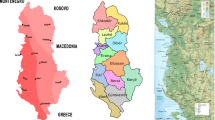Abstract
This study compared and analyzed both the energy savings and cost-effectiveness of various energy-saving technologies retrofitted to common buildings in China. Base models for an office and store building, set in representative climate zones of China—Beijing, Shanghai, and Guangzhou—were established and calibrated in EnergyPlus, a building energy simulation software program. Various energy-saving technologies were then applied to these models in EnergyPlus to calculate the overall energy savings under different climate conditions. In addition, a payback analysis was performed to determine the cost-effectiveness of each technology. The final results of this study can serve as a preliminary reference for selecting effective and economical energy-saving technologies to retrofit existing public buildings.
Similar content being viewed by others
References
(2002) International Performance Measurement and Verification Protocol (IPMVP) Volume 1.
Ecofys for EURIMA (2004). Mitigation of CO2 emissions from the building stock.
Ecofys for EURIMA (2005). Cost-effective climate protection in the EU building stock of the new EU member states.
Fang, G. (2007). Master’s degree thesis: Chongqing public building energy simulation and energy research. Chongqing University.
Griffith, B., Long, N., Torcellini, P., & Judkoff, R. (2007). Assessment of the technical potential for achieving net-zero energy buildings in the commercial sector[R]. Technical Report NREL/TP-550–41957.
Kneifel, J. (2010). Life-cycle carbon and cost analysis of energy efficiency measures in new commercial buildings. Energy and Buildings, 42, 333–340.
Li, Y., Pan, Y., & Chen, C. (2008). Shanghai, both office building envelope of energy-saving measures, refrigeration and air conditioning. 22(6), 60–64.
Ma, Z., Cooper, P., Daly, D., & Ledo, L. (2012). Existing building retrofits: methodology and state-of-the-art[J]. Energy and Buildings, 55, 889–902.
Nikolaidis, Y., Pilavachi, P. A., & Chletsis, A. (2009). Economic evaluation of energy saving measures in a common type of Greek building. Applied Energy, 86, 2550–2559.
Wu, Z., & Long, W. (2008). Optimum analysis on building envelope energy efficient reform and air conditioning operating modes for public buildings in Shanghai, HVAC HV & AC 38(3), 42–45.
Xie, Z. (1999). Shanghai public building energy consumption status and recommendations on energy saving. Energy Saving (11), 25–27.
Xu, P., Shen, Y., & Hua, J. S. (2012). Effectiveness of energy retrofit methods in public buildings in China; Heating Ventilating & Air Conditioning.
Jiang, Y. (2007). China’s energy situation and focus on building energy consumption, construction technology 26–29.
Zhao-phase, Ren, J., & Yang, S. et al. (2008). Guangzhou office type building energy consumption and energy saving potential analysis survey. Tenth National Building Physics Conference Proceedings 74.
Xue, Z., & Jiang, Y. (2004). Beijing large public building energy situation and energy saving potential analysis, HVAC HV & AC, 34(9), 8–10.
Author information
Authors and Affiliations
Corresponding author
Appendices
Appendix 1
Appendix 2
Rights and permissions
About this article
Cite this article
Xu, P., Shen, Y., Chen, L. et al. Assessment of energy-saving technologies retrofitted to existing public buildings in China. Energy Efficiency 9, 67–94 (2016). https://doi.org/10.1007/s12053-015-9350-6
Received:
Accepted:
Published:
Issue Date:
DOI: https://doi.org/10.1007/s12053-015-9350-6












